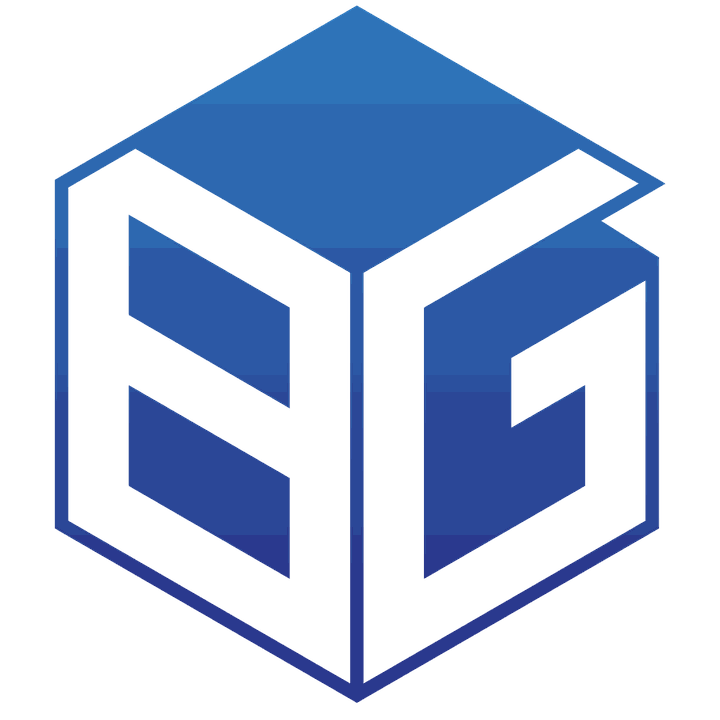
In recent years, decentralized finance (DeFi) has emerged as a game-changer in the world of cryptocurrencies. With the growing popularity of DeFi protocols, it has become crucial for cryptocurrency investors to manage their portfolios effectively. In this blog post, we will explore the top 5 DeFi tools that can help you streamline and optimize your crypto portfolio management in 2023.
Introduction to DeFi and Crypto Portfolio Management
Decentralized finance (DeFi) refers to the use of blockchain technology and smart contracts to create financial products and services that are accessible to anyone without relying on intermediaries. The rise of DeFi has led to an explosion of new opportunities for crypto investors, but managing a diverse portfolio of digital assets can be challenging without the right tools.
Portfolio in crypto?
The term “portfolio” is commonly used in finance to refer to a collection of assets. In the realm of cryptocurrency, portfolios serve as a means for users to monitor and manage their growth in the DeFi space, encompassing various asset classes. Similar to an “egg basket,” an investment portfolio involves selecting and storing assets such as token groups and stablecoins within it.
Given the multitude of coins and tokens in the crypto market, investors typically opt to filter through platform coins like layer 1 and layer 2 options. Once a promising coin has been identified, the investor determines the amount of capital to allocate toward it. Subsequently, tokens are purchased and stored in a wallet, constituting the action of adding assets to the portfolio. It is worth mentioning that some users prefer storing their coins directly on exchanges rather than creating a separate portfolio on a wallet.
However, it is important to note that most exchanges operate as centralized exchanges (CEX), thereby subjecting funds stored on them to various risks such as cyberattacks, security vulnerabilities, or potential leakage of user information. To mitigate these risks and facilitate more efficient asset management, it is advisable for users to consider creating portfolios on supporting applications.
Importance of Effective Crypto Portfolio Management- Defi Tools
Managing a crypto portfolio requires careful attention to various factors such as asset allocation, risk management, tracking performance, and rebalancing. Without proper management, investors may miss out on potential gains or expose themselves to unnecessary risks. This is where DeFi tools come into play, offering innovative solutions to streamline portfolio management processes.
Coin98 Exchange (Coin98 Portfolio)
Coin98 Exchange is a decentralized exchange (DEX) with a Multi-chain liquidity aggregation platform, solving liquidity problems across multiple blockchains and enhancing the user experience in DeFi completely.
The platform is also known as DeFi All-in-one, the Decentralized & Non-custodial version of CEX exchanges on the market. In particular, Coin98 offers many products to support Exchange trading, provide market information, and track portfolio management such as Portfolio, among many other preeminent features.
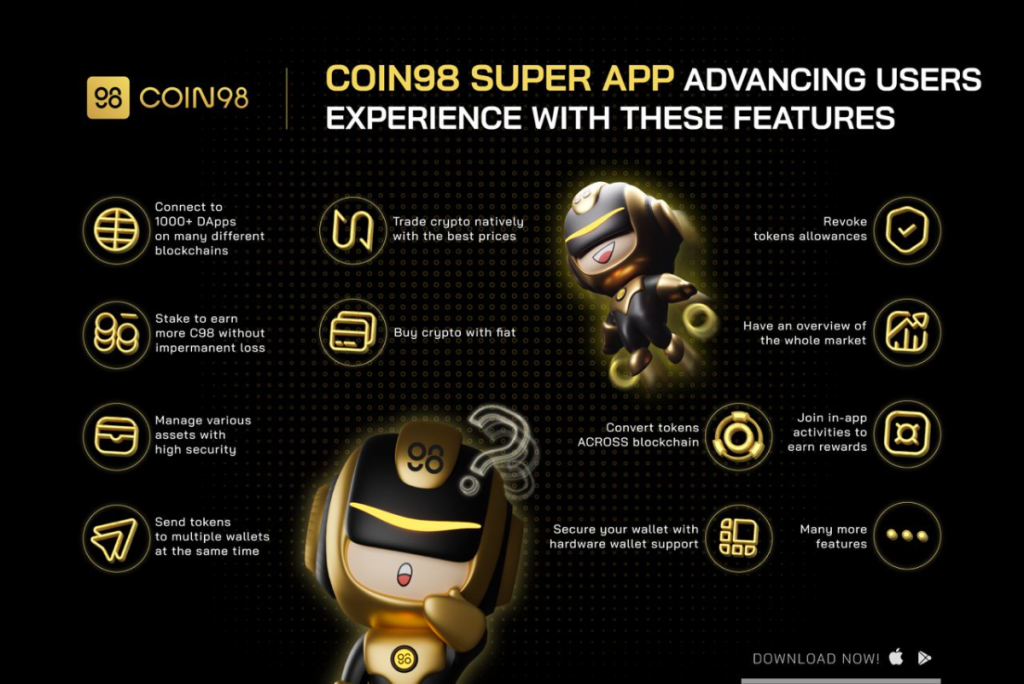
Coin98 Portfolio is a support-focused product that makes it easy for users to create crypto portfolios, allowing anyone to track and manage the growth of assets in the DeFi space without recovering each wallet for individual viewing.
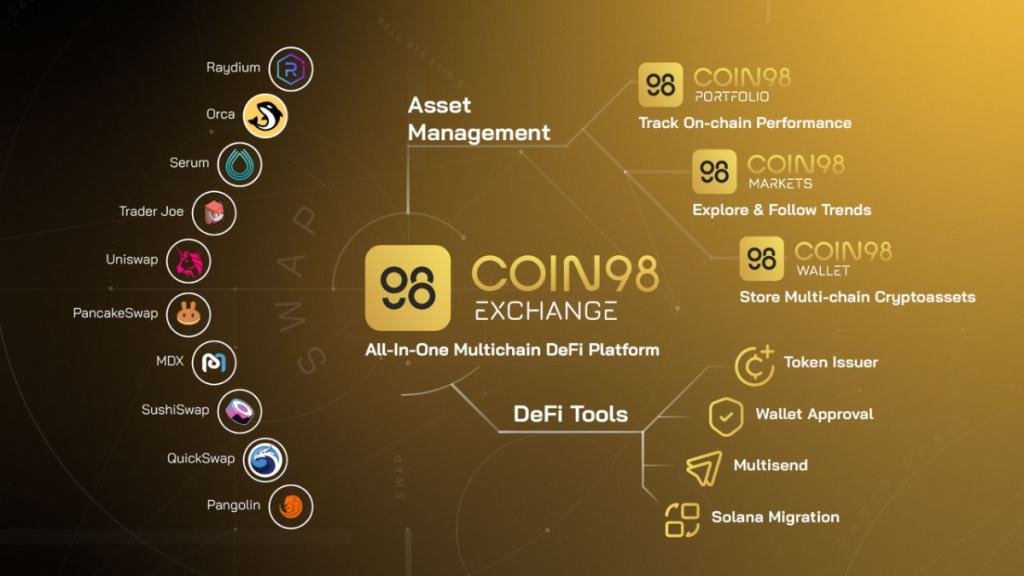
Decentralization in blockchains presents both advantages and limitations in the management and observation of token/coin volatility. This tool serves to enable individuals to track on-chain information across multiple chains, eliminating the need for multiple Explorer browsers. Despite being a later entrant in the field, Coin98 has effectively developed and possesses numerous outstanding features, including comprehensive multi-chain support. Coin98 Portfolio has successfully facilitated portfolio tracking across various blockchains such as Ethereum, BNB Chain, Solana, Avalanche C-Chain, Tron, Near, Polkadot, HECO Chain, TomoChain, Celo, and Kusama. In addition to normal tracking functions, Coin98 further enhances user experience by suggesting chains for users to select and save previously tracked addresses associated with their wallets.
Ape Board
Ape Board is a comprehensive cross-chain dashboard that offers a multitude of features to facilitate the management of assets across multiple wallets simultaneously. Keeping abreast with the current trend of multi-chain, Ape Board has embraced and enhanced its ecosystem by incorporating over 392 protocols and 36 blockchains, including Ethereum, BNB Chain, Solana, Polygon, Avalanche, Fantom, and Arbitrum, among others.
The Ape Board portfolio management tool encompasses various insights sourced from Ape Radar and Ape Bridge. Moreover, the system extends support to wallets on Binance exchange, enabling users to effortlessly view and manage their assets on the Apeboard platform without the need for cumbersome reconnections.
At the homepage of the Ape Board, users can observe the indicators of the asset in the Dashboard such as:
- Net worth: Net worth.
- Claimed.
- Total Assets: Total Assets.
- Total Debts: Total Debt.
Each profile or wallet will be divided into three sections:
- Portfolio: Displays the price of coins/tokens.
- History: Statistics on the number of transactions and the total amount of gas fees consumed.
- Analytics: Describes information about asset types, chart-traded indices.

In addition, to meet the needs of transferring tokens back and forth between chains, Apeboard also has a bridge tool to help users transfer assets back and forth between chains flexibly.
Zapper
Zapper is a DeFi Aggregation Layer, making it easier for users to interact with DeFi projects, the project possesses features such as Zapper API (creating LPs and prices on AMM, supporting bridging different networks), Smart contracts, and Zap (supporting liquidity on multiple chains).
In addition, Zapper is also a professional asset management dashboard with more than 14 EVM blockchains and various coins/tokens. Users can use Zapper to retrieve asset information, and adjust the category inside.
Zapper has many advantages such as support for swapping, converting, and sending tokens right on the dashboard, users can experience Zapper on many applications such as websites, and other mobile devices such as phones. In addition, during use (completing tasks) Zapper can also be lucky to receive NFT rewards from the system.
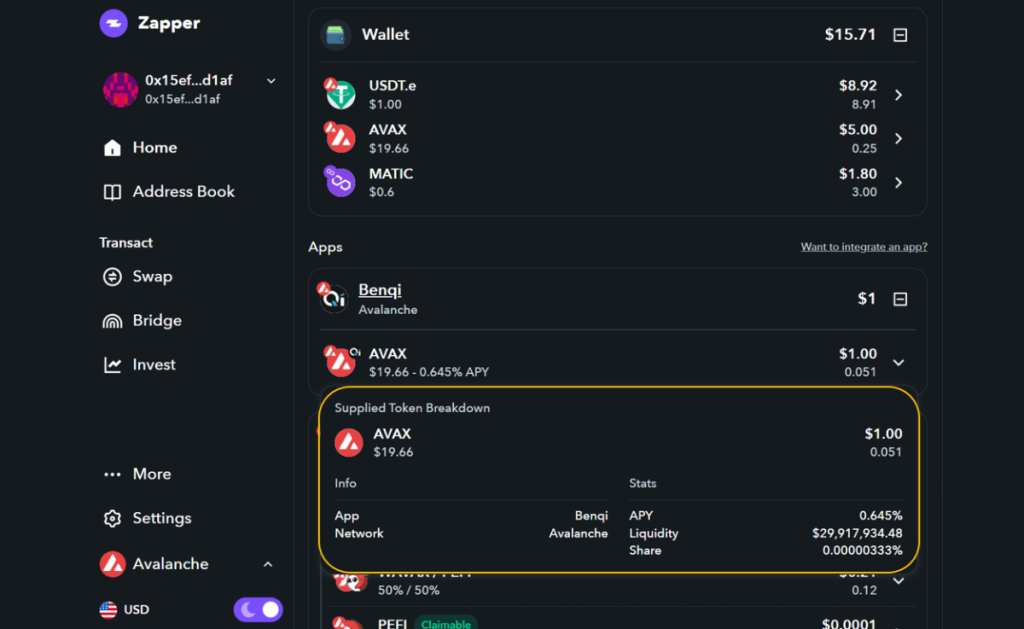
The Zapper Portfolio is designed to present various parameters regarding asset distribution across products, dApps, and blockchains. It categorizes assets into two main groups: Wallet (assets held in the wallet) and dApp (assets utilized in farming, staking, or sent within the dApp). The portfolio also provides valuable information about blockchains, liquidity pairs, and the value of assets within the dApp.
Similar to Apeboard, Zapper offers a historical catalog that enables users to effectively monitor their past transactions, organized based on chronological and network orders. However, it is important to note that the limitation of unsupported blockchain data restricts users from tracking transactions on chains not supported by Zapper’s ecosystem.
Debank is a protocol with the goal of providing a comprehensive wallet solution (all-in-one) in DeFi, Debank promotes branding with many outstanding features such as DEX Aggregator, Data Analysis, and Portfolio.
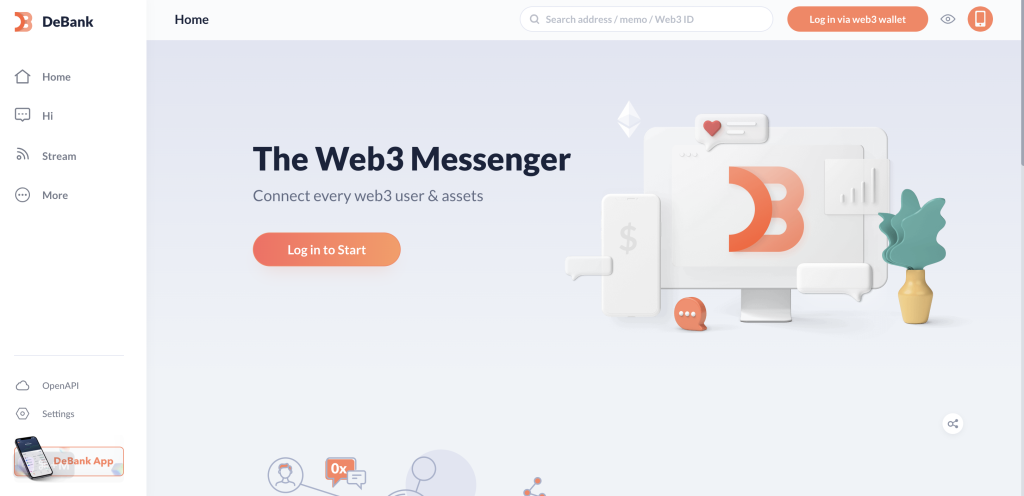
Where:
- DEX Aggregator: Supports many different DEXs (Decentralized Exchange), and supports users to swap (swap) tokens easily.
- Data Analysis: Shows many important parameters such as TVL, transaction volume, and transactions…
- Portfolio: Help users manage assets across multiple chains with data from Analysis.
Debank Portfolio, also referred to as a portfolio board, shares similarities with a tracking wallet in DeFi. It offers the advantage of supporting and seamlessly connecting Metamask wallets while allowing for flexible switching between multiple accounts. Currently, the Debank ecosystem integrates over 35 blockchains, empowering users to personalize profiles and monitor fundamental metrics within their portfolios. These metrics include ID, wallet address ranking, number of followers, and total ownership value on blockchains.
Furthermore, users can conveniently keep track of wallet addresses by creating their own Bundle and grouping them for easy monitoring. Although Debank is currently testing a new feature called Feed that specializes in the NFT segment, it has not yet been officially launched or operationalized.
Thanks to data analysis capabilities, Debank offers a dedicated section for Web 3 keywords. This ranking is generated by Debank based on the scores of active user addresses in terms of transactions and other related activities. Such metrics effectively reflect the flow of money among individuals or organizations engaged in DeFi transactions, akin to network explorers found across various platforms.
How to use Debank Portfolio, you can visit: https://debank.com/
Zerion
Zerion is a DeFi investment tool in Web 3 and NFT (also known as DeFi Dashboard), with a Zerion-friendly interface that allows users to track their assets in the most general way. In the dashboard, users can manage assets and allow searching information about that asset group through exploration.
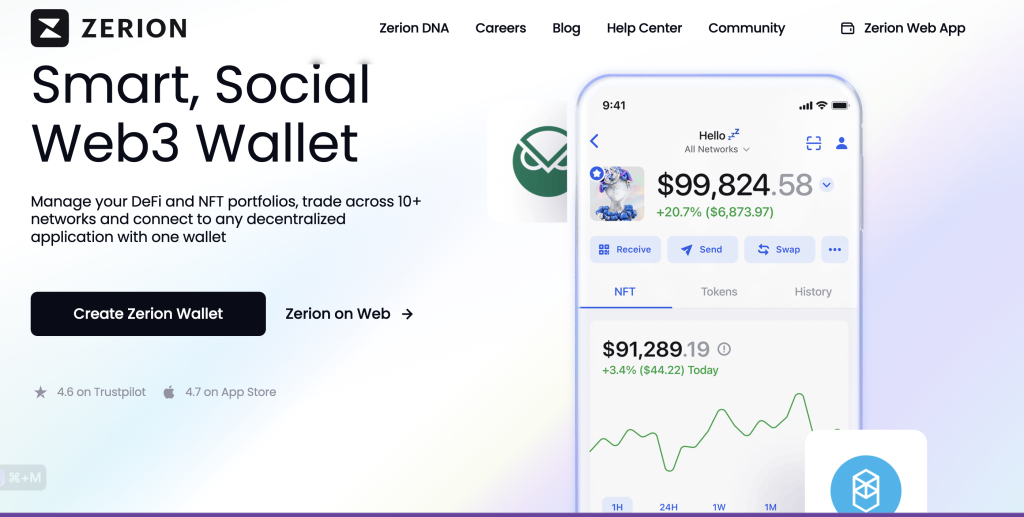
Zerion has successfully integrated over 10 EVM blockchains, each with its own unique features including token swapping and conversion capabilities.
Additionally, Zerion has developed a non-custodial wallet within its ecosystem, offering advanced functionalities such as multi-chain transactions and real-time bridge discovery for seamless interoperability. Users who have an account on Zerion will benefit from the automatic addition of their owned tokens and coins to the tracking list, eliminating the need for manual entry and enhancing the overall user experience.
The merger of Zerion and Zerion Wallet requires users to log in to their wallet accounts in order to access the portfolio interface, where stored assets will be displayed. Furthermore, users with existing wallets can easily connect to Zerion for convenient tracking and DeFi asset management.
Conclusion
As the DeFi ecosystem continues to evolve and attract more participants in the coming years, effective crypto portfolio management will play a crucial role in achieving investment objectives. The five DeFi tools discussed in this blog post – offer innovative solutions to streamline portfolio management processes and optimize returns.
Each tool comes with unique features catering to different investor preferences and strategies. Whether you are an active trader seeking advanced trading capabilities or a passive investor looking for automated rebalancing options, there is a suitable DeFi tool available for you in 2023.
By leveraging these powerful tools alongside sound investment principles, crypto investors can confidently navigate the rapidly changing landscape of decentralized finance while maximizing the potential of their portfolios.
